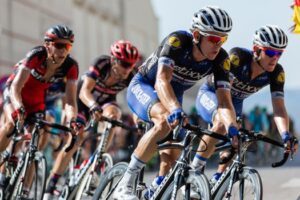Why Athletes Need Electrolytes

Why Athletes Need Electrolytes
When it comes to ramping up your endurance and performance, nutrition is more than calories and hydration. In fact, every training session, every competition, and every recovery window depends on a delicate balance of electrolytes. Specifically, sodium, potassium, magnesium, calcium, and chloride regulate muscle contraction, nerve signaling, fluid balance, and even heart rhythm. Therefore, when you lose too much through sweat without replacing it, performance begins to unravel.
The Risk of Drinking Only Water During Endurance Training

During long workouts or races, sweat loss is more than just water. Along with fluids, sodium, potassium, and other electrolytes leave the body with every drop. If you replace only water, the blood becomes diluted, lowering sodium concentration. This can lead to hyponatremia, a potentially dangerous condition characterized by nausea, vomiting, confusion, and in severe cases, collapse.
In addition, athletes may also face hypokalemia, a drop in blood potassium. Potassium is critical for muscle contraction and heart function. Even though it is less common than sodium loss, the impact is still significant. For example, even mild deficiencies can impair performance, while severe cases may cause muscle weakness and cardiac arrhythmias.
Athlete Case Study: How the Wrong Hydration Strategy Hurts Performance
I’ve worked with many athletes who learned this lesson the hard way. For instance, one runner came to me after repeatedly getting sick during long runs. They described a “sloshing” feeling in the stomach and nausea that forced them to slow down or stop. Ultimately, the cause was clear: drinking large amounts of plain water without adding electrolytes. The imbalance not only hurt performance but also created a fear of long-distance training. Once we individualized their hydration strategy – tailoring both fluids and electrolytes to their sweat rate, sport, and race conditions – the problem disappeared, and their endurance improved dramatically.
How Electrolytes Improve Endurance, Recovery, and Performance

Electrolytes are not just about avoiding problems. On the contrary, they are the foundation of sustained endurance. Research shows that electrolytes for endurance athletes help:
-
Delay fatigue and sustain intensity for longer
-
Reduce cramping and prevent muscle soreness
-
Maintain sharper focus and decision-making
-
Improve glycogen replenishment and recovery
This is why electrolyte replacement should be part of every hydration and electrolyte balance for performance, not left as an afterthought.
Practical Electrolyte Strategies for Endurance Athletes

-
Know Your Sweat Rate and Composition
Every athlete loses different amounts of fluid and sodium. As a result, testing your sweat rate is the first step toward a customized hydration plan. -
Fuel Strategically During Training and Races
For sessions longer than 60-90 minutes, plain water is not enough. Instead, use an electrolyte drink that matches your needs. -
Balance Carbohydrates and Electrolytes
Carbs fuel muscles, but without sodium and potassium transport, glucose uptake is impaired. This means the two work together to sustain performance. -
Recover with More than Calories
Replenish both glycogen and electrolytes post-training to speed recovery and prepare for the next session.
Why Every Athlete Needs a Personalized Electrolyte Plan
Understanding your own needs is the difference between guessing and performing. That’s where I come in. In my Introductory Nutrition Session we evaluate your training demands, sweat losses, and fueling strategy. You’ll leave with a practical, personalized plan that makes hydration and electrolytes a performance advantage, not a weakness.
If hydration is a challenge for you, I recommend reading my article Hydration for the Serious Athlete. Together, these two strategies – fluids and electrolytes – will elevate your endurance and performance.
Final Thought
Electrolytes are the unseen drivers of endurance. If ignored, they can lead to cramps, fatigue, sloshing, or dangerous imbalances like hyponatremia. However, when mastered, they unlock consistency, resilience, and peak performance.
